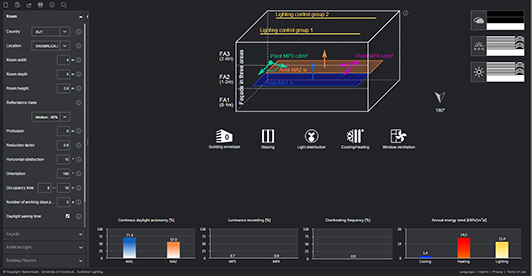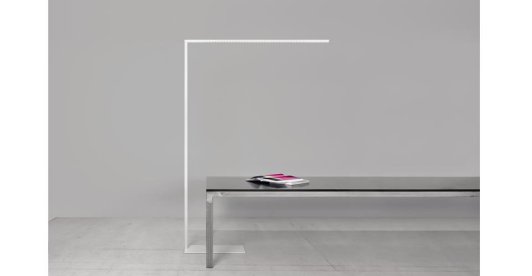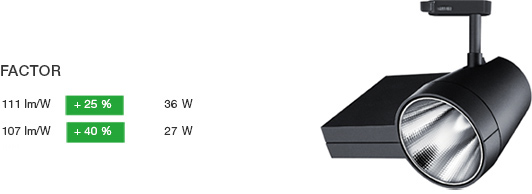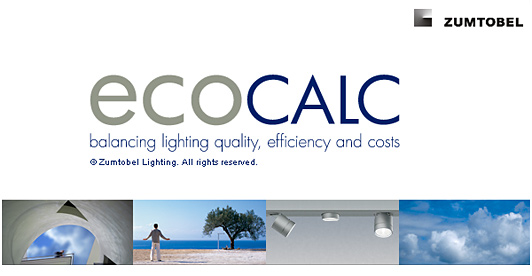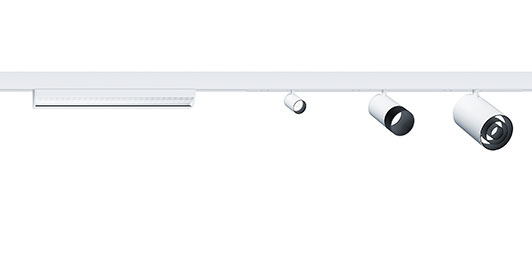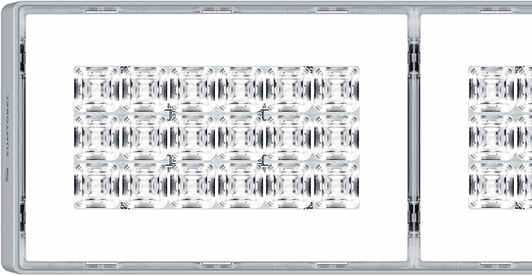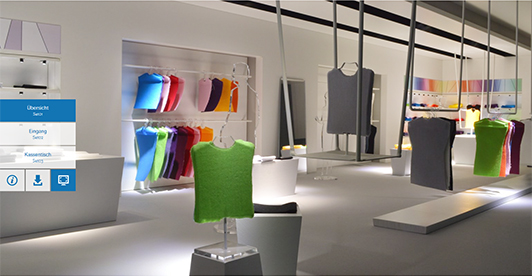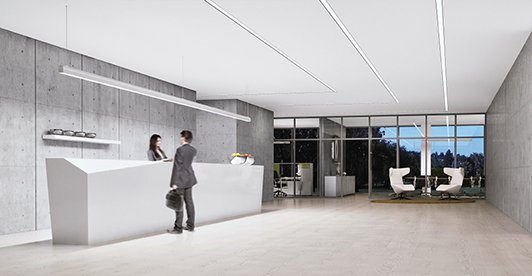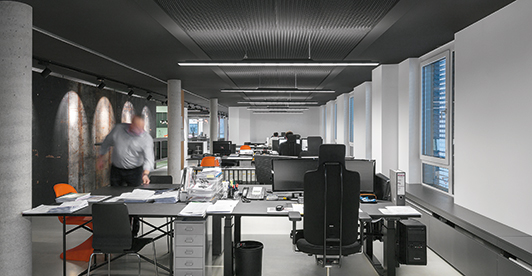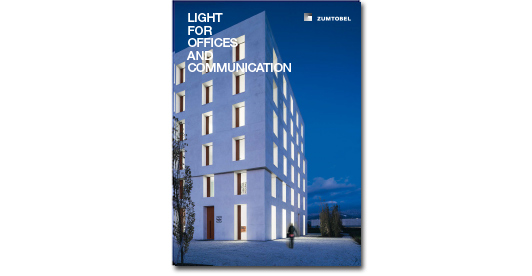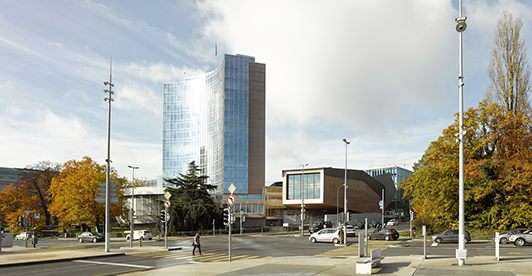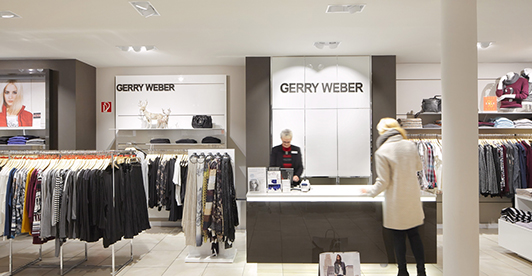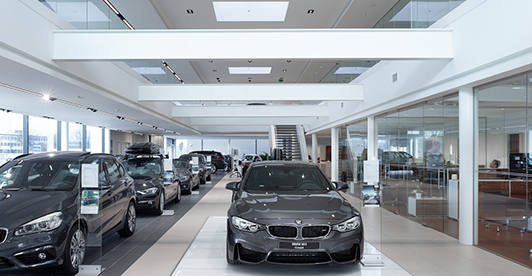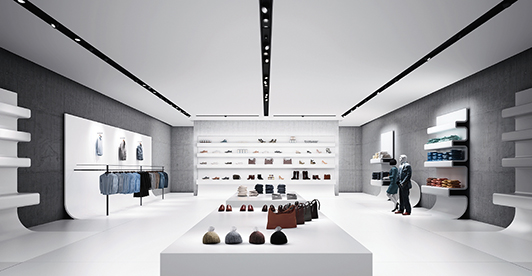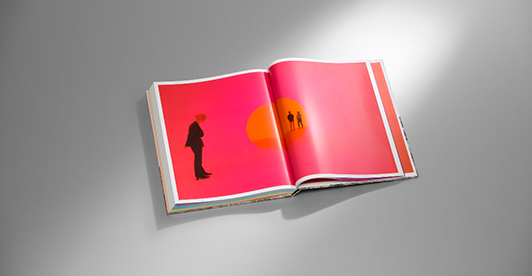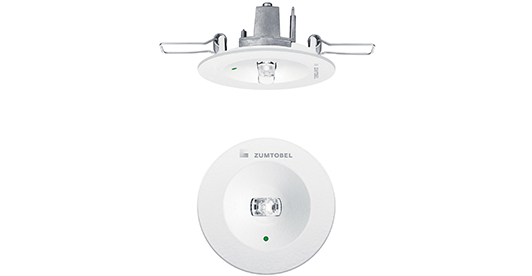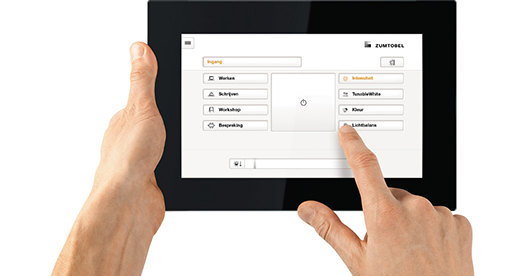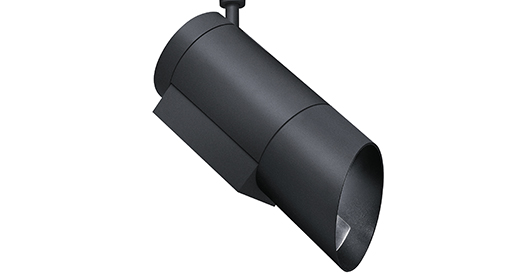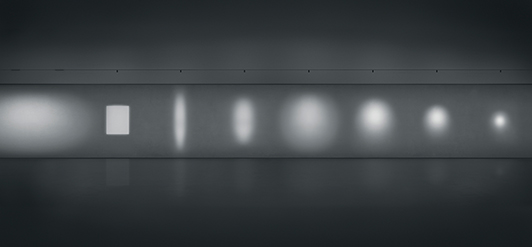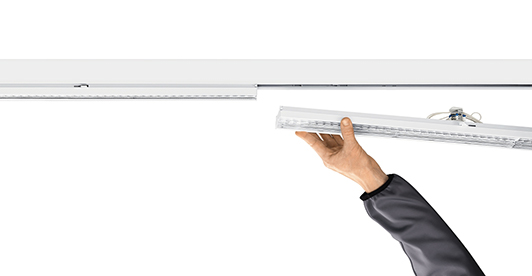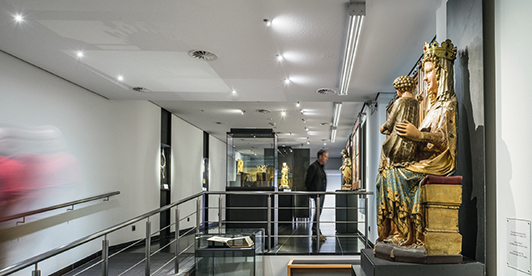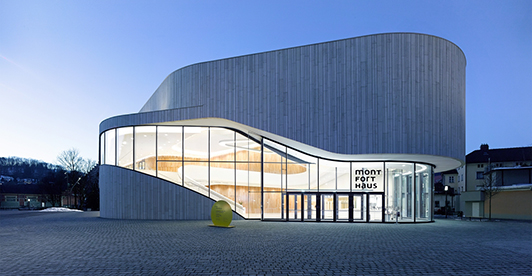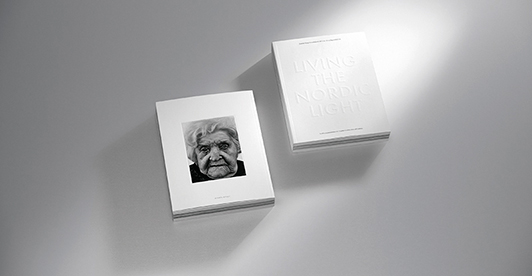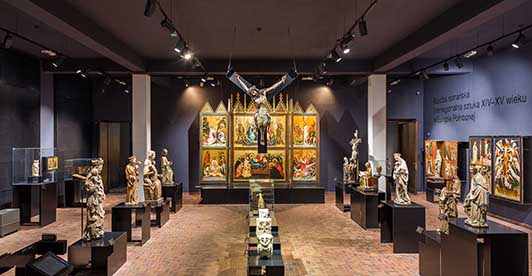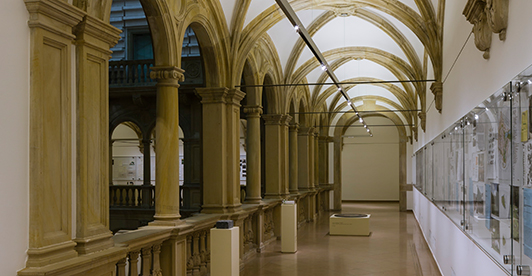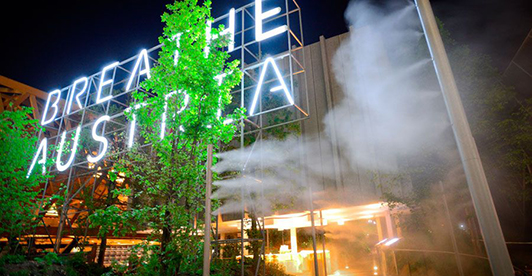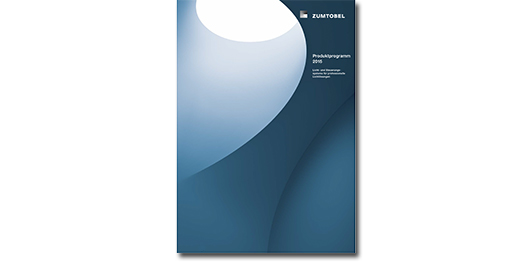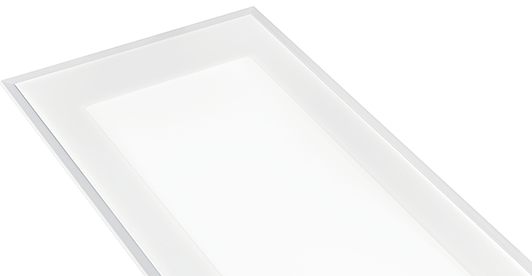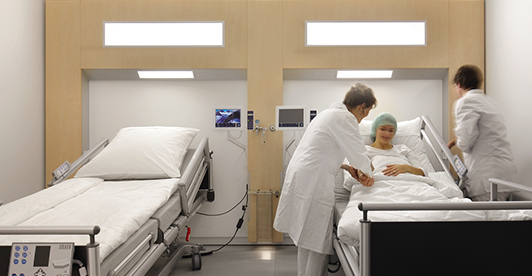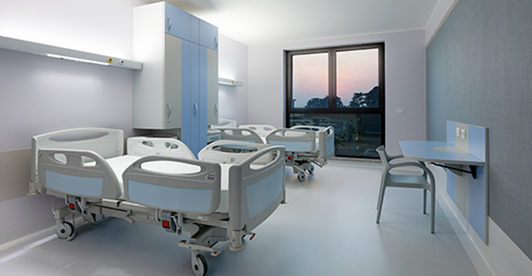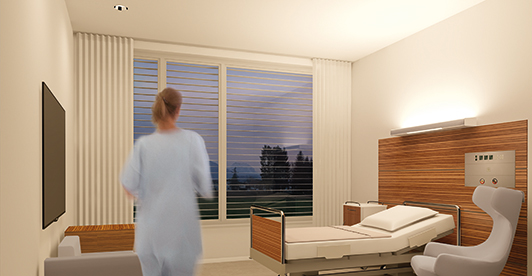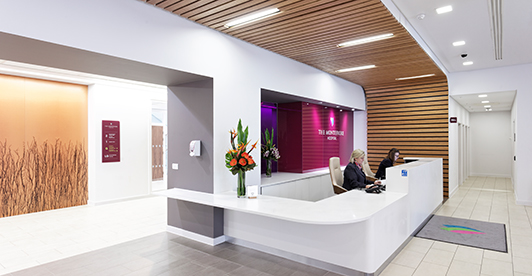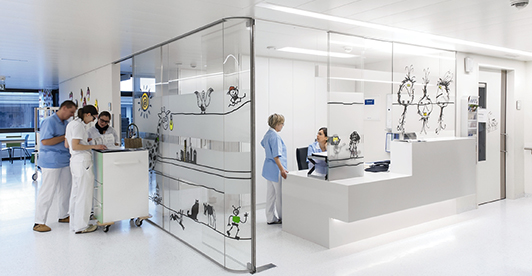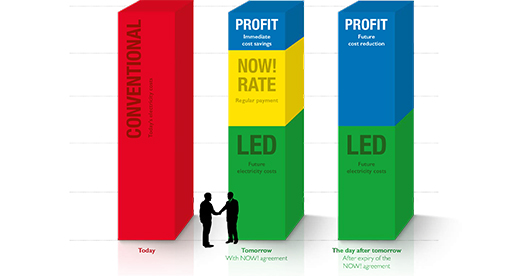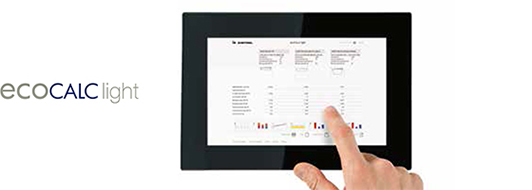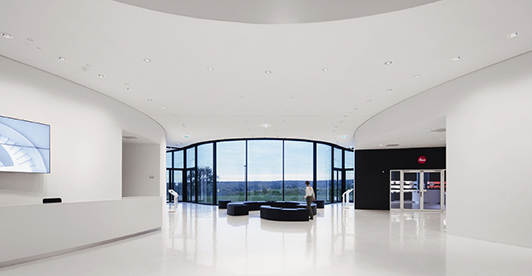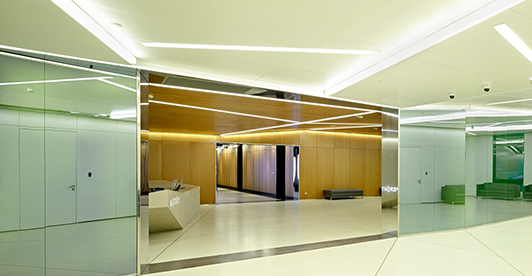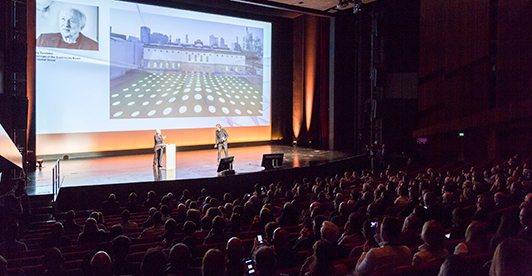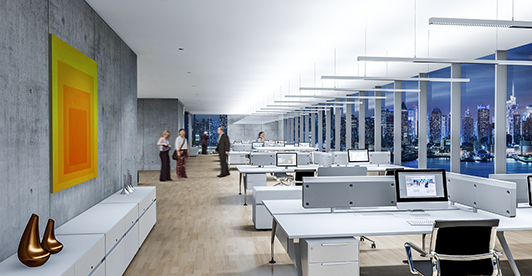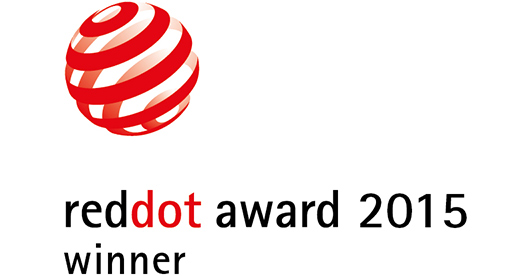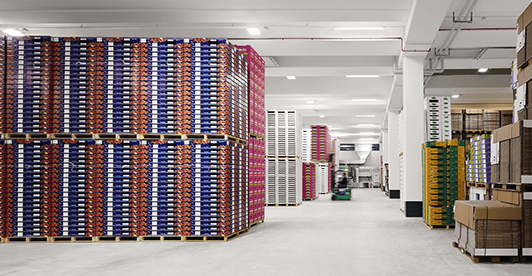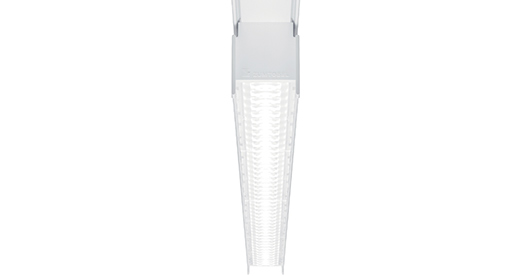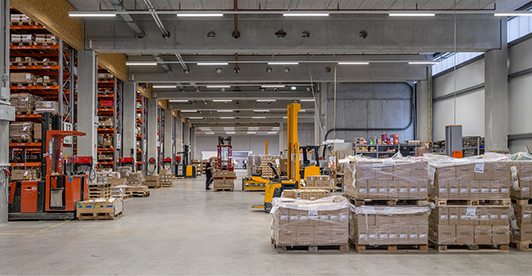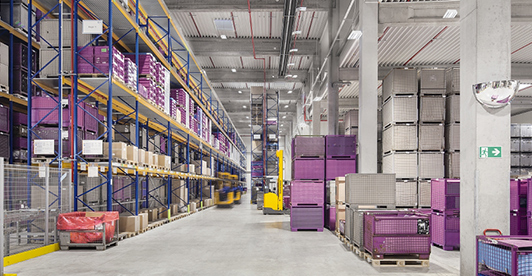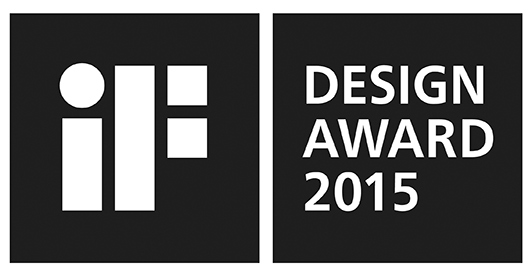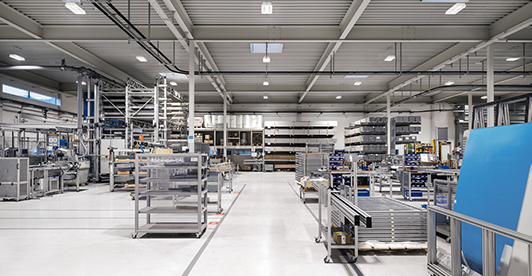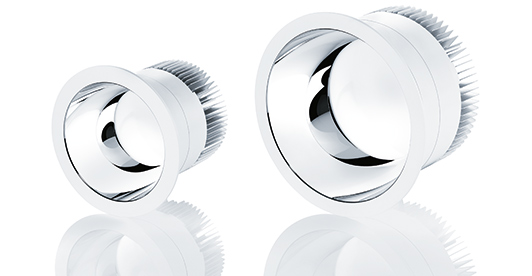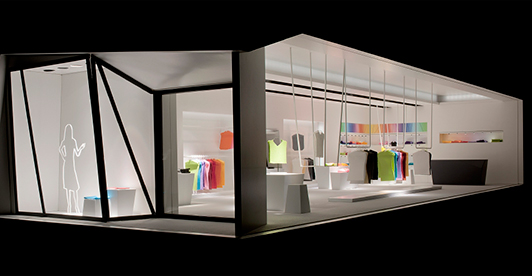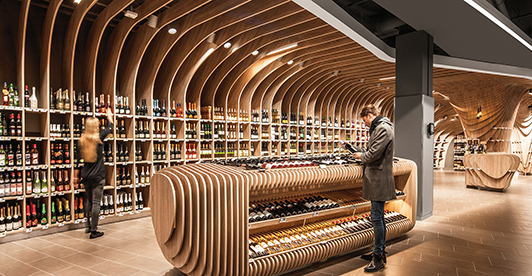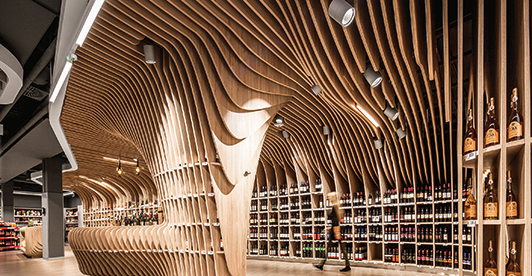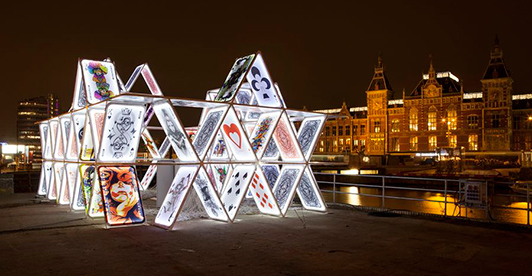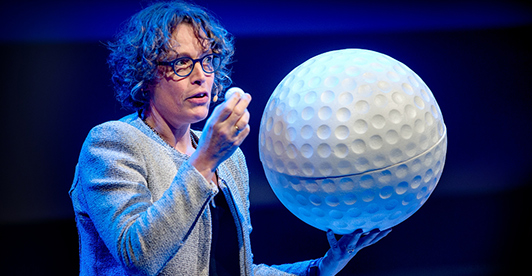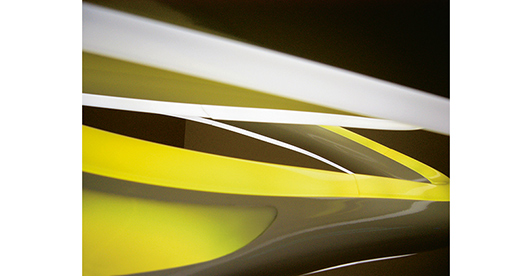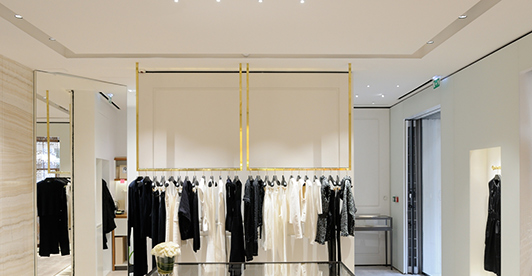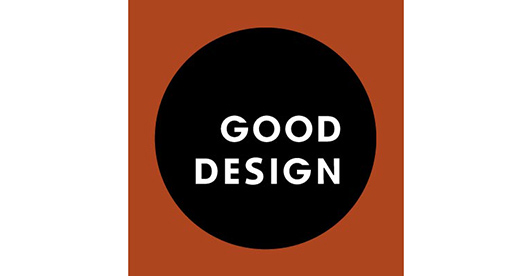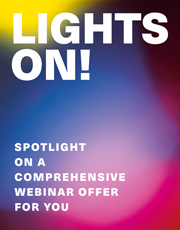Latest News 2015
-
12/2015Lighting Solution
State-of-the-art LED-only solution for the St Martin Tower in Frankfurt
At the beginning of July, the St Martin Tower was opened in Frankfurt. The St Martin Tower designed by the architects of msm meyer schmitz-morkramer consists of a wing-shaped tower and a U-shaped wing, incorporating a total rental area of more than 24 000 square metres.More informationLess informationThe design of the St Martin Tower meets the highest demands in terms of sustainability and quality of life at the workplace. An integral and flexible LED lighting solution by Zumtobel was installed in the entire building. Read in our project report about the shining new jewel of the Frankfurt skyline, which managed to obtain pre-certification with a “Silver” certificate of the German Sustainable Building Council (DGNB).
» Go to the project reportZumtobel. The Light.
-
share it
-
-
12/2015Company
DALEC – concept analysis tool for integral lighting design
What will be the total energy requirements of the building? For financial planning purposes, a building operator needs an answer to this question even before the construction work begins.More informationLess informationUntil now, no tool has been available on the market which can quickly calculate a building's energy requirements already at an early design stage, taking into account various influencing factors such as the interaction of daylight and artificial lighting as well as the impact on heating and cooling requirements.
In the context of the DALEC (Day and Artificial Light with Energy Calculation) research project, which is implemented by Zumtobel in collaboration with Bartenbach and the University of Innsbruck, such a concept analysis program for integral lighting design is currently being developed. A prototype is already available.
» Go to prototypeZumtobel. The Light.
-
share it
-
-
12/2015Products
Iconic Design Award 2016: Interior Innovation – Best of Best goes to LINETIK
The German Design Council initiated the Iconic Design Award: Interior Innovation in order to interrelate the worlds of architecture and interior design. In this context, Zumtobel has managed to chalk up a great success: the LINETIK free-standing LED luminaire won the “Best of Best” label.More informationLess informationWhen developing the LINETIK free-standing LED luminaire, the designers and engineers challenged everything valid so far in terms of office lighting and design. The result is a luminaire that provides maximum lighting comfort at really any workstation while requiring minimum resources.
» Read more about LINETIKOther award-winning products
The following Zumtobel products were also awarded at the Iconic Design Award 2016: Interior Innovation:
• » SEQUENCE surface-mounted and pendant LED luminaire
• » SUPERSYSTEM LED lighting system
• » CAELA wall-mounted, surface-mounted and pendant LED luminaireZumtobel. The Light.
-
share it
-
-
12/2015Event
Bi-City Biennale of Urbanism/Architecture in Shenzhen
The Bi-City Biennale of Urbanism/Architecture (UABB) in Shenzhen is dedicated to urban development and architecture, providing a platform for discussions about the role of light and shadow in urban spaces.More informationLess informationUnder the motto “Re-Living the City”, new and innovative approaches that will improve not only the quality of urban life but also its efficiency will be presented from 4 December 2015. This year's UABB will be curated, among others, by Aaron Betsky, Alfredo Brillembourg, Hubert Klumpner and Doreen Heng Liu, internationally leading architects, researchers and critics in this sphere.
» More about the eventZumtobel. The Light.
-
share it
-
-
11/2015Products
Overview of Zumtobel products with increased efficiency
The rapid development of LED technology quickly increases the efficiency of products, with lighting quality maintained at a consistently high level.More informationLess informationIn order to always keep you up to date with respect to which specific Zumtobel products have become more efficient over the past months, you can call up a list on our website that is updated on an ongoing basis.
» Go to listZumtobel. The Light.
-
share it
-
-
11/2015Company
ecoCALC is now also able to factor in NOW! – light that pays for itself
ecoCALC is a tried-and-tested calculation program for evaluating a lighting solution's total costs over its entire service life. The new version now also allows you to calculate lighting solutions where use is made of light as a service. With “NOW! – light that pays for itself” you get the best light without having to buy any luminaires or worry about their maintenance and repair.More informationLess informationBased on the lighting solution you entered in ecoCALC, the new module will quickly calculate the estimated NOW! instalment you would have to pay. You can then compare this calculation with your existing lighting solution or with other alternative solutions.
» Read more about NOW! – light that pays for itself
» Download ecoCALCZumtobel. The Light.
-
share it
-
-
11/2015Products
SUPERSYSTEM wins German Design Award 2016
The renowned German Design Council has honoured Zumtobel's SUPERSYSTEM LED lighting system with the German Design Award 2016.More informationLess informationThanks to its minimalist design, SUPERSYSTEM is the ideal solution wherever the luminaire is not supposed to dominate the architecture and interior. In order to realise future lighting tasks using one consistent system, Zumtobel has developed the next generation of SUPERSYSTEM. The multifunctional and multifaceted lighting system is now able to fulfil lighting tasks in a variety of application areas within a homogeneous infrastructure in a highly appealing manner. The awarding ceremony will take place in Frankfurt on 12 February 2016.
» Read more about SUPERSYSTEMZumtobel. The Light.
-
share it
-
-
10/2015Products
SEQUENCE – the modular pendant and surface-mounted LED luminaire
SEQUENCE has been developed in collaboration with in-house and external architects, lighting designers and other designers: a completely new luminaire that focuses on visual tasks in offices and fully exploits the opportunities of cutting-edge LED technology has been created.More informationLess informationThe luminaire features perfect glare control and is supplied in lengths of 1200 mm (8 lighting modules) or 2100 mm (14 lighting modules). With up to 100 lm/W at a luminous flux of up to 9650 lm, SEQUENCE facilitates economically efficient working in offices.» Go to product page
Zumtobel. The Light.
-
share it
-
-
10/2015Company
VIVALDI makes your visualisations more intelligent – now also online
The interactive VIVALDI design tool reflects the individual luminaire groups of your lighting solution and thus allows you to adjust the lighting scenes in a visualisation in real time at any time. As a result, you can also design perfect lighting effects over the course of a day.More informationLess informationDownload the desktop version and work with images from all lighting calculation and visualisation programs currently used as well as with photographs.
You can also try out VIVALDI here on the online player. Call up predefined lighting scenes or adjust the sliders yourself.
» Go to full version
» Go to online playerZumtobel. The Light.
-
share it
-
-
10/2015Products
SLOTLIGHT infinity – the world's first continuous light line
SLOTLIGHT infinity enables to create nearly endless light lines, up to 20 metres in length, without any butt joints and with uniform illumination even around corners.More informationLess informationThanks to its innovative design, the individual assembly steps are now made even easier and, when installed flush with the ceiling, an attractive transition is also ensured. For more information on SLOTLIGHT infinity, please visit our product page.
» Go to product pageWatch the installation video that provides step-by-step instructions on how to install SLOTLIGHT infinity.
» Go to installation videoZumtobel. The Light.
-
share it
-
-
10/2015Lighting Solution
Planquadrat Gaiser & Partner architects rely on perfect lighting in their office
The architectural studio of Planquadrat Gaiser & Partner was established eight years ago with a focus on team spirit. This idea is also reflected in the interior of the new location in Sigmaringen, which allows staff members to exchange ideas in an open space. Thirteen employees are accommodated on a floor space of about 400 square metres.More informationLess informationThe SEQUENCE pendant LED luminaire, matched in colour to the black ceiling, ensures optimum illumination and perfect glare control with high quantities of light. The VIVO LED spotlight creates interesting accents on the walls – some of which can be moved – that are also used as projection screens. In the entrance area and the corridors, SLOTLIGHT II provides a clear line of uniform illumination.Zumtobel. The Light.
-
share it
-
-
10/2015Lighting Solution
All you need to know about office lighting
You will find all relevant information regarding office lighting in our "Light for Offices and Communication" brochure.More informationLess informationRead how you can increase people' sense of well-being at the workplace, create identity and reduce costs. Aside from numerous design examples, the brochure also includes information on how a Zumtobel lighting solution can contribute to LEED® certification.Zumtobel. The Light.
-
share it
-
-
10/2015Company
How much does the need for artificial lighting depend on the season?
The global study on lighting quality perceived in offices conducted by Zumtobel and the Fraunhofer IAO shows: some 72 per cent of those surveyed use artificial lighting for more than six hours on winter days.More informationLess informationFor the brighter summer months, some 33 per cent of those surveyed indicated the same number of hours. This demonstrates the high significance of lighting in everyday work and shows how important it is to perfectly match daylight and artificial lighting.
You want to know more about preferred lighting scenes in offices to increase people's sense of well-being and reduce costs? Download the study on lighting quality perceived in offices.Zumtobel. The Light.
-
share it
-
-
09/2015Lighting Solution
Gerry Weber increases sales by 10 % with Limbic® Lighting
In the course of a field test, the only thing that was changed at the Gerry Weber shop in Herford, Germany, was the light. Zumtobel LED spotlights based on Limbic® Lighting were used to address Gerry Weber's target group to optimum effect. The shop is characterized by a friendly, bright atmosphere and a warm colour temperature of 3000 K.More informationLess informationFor two months, the general buying behaviour before and after installation of the new lighting system was monitored, and some customers were also tested using a special procedure. The sales were also compared to those of a reference shop in the same period.
The result is clear: the adjustment of the lighting situation according to target group-specific lighting preferences achieved a sales increase of 10 % as well as a similar increase in transaction values compared to the reference shop in the same time period.Zumtobel. The Light.
-
share it
-
-
09/2015Lighting Solution
Future-proof lighting solution for BMW Gregoir in Puurs
As regards the design of the new BMW Gregoir car dealership in Puurs, Belgium, the perfect presentation of the premium vehicles was paramount. Zumtobel's innovative lighting concept was created in close collaboration with the architects and the electrical design engineer.More informationLess informationThe enticing interplay of light and shadow highlights the vehicles' clear lines. In order to achieve this, Zumtobel used the modular INTRO lighting system.
For more detailed information on the integral lighting solution, which also incorporates the ONLITE resclite emergency lighting system and the LITECOM lighting management system, please visit our project report.
» Read more
Zumtobel. The Light.
-
share it
-
-
09/2015Products
INTRO – the all-rounder in the shop
The modular INTRO lighting system combines different luminaire types based on state-of-the-art LED technology and sets any shop centre stage to optimum effect.More informationLess informationYou benefit from a solution suitable for maximum personalisation, a modular system that fulfils the various lighting tasks for shop and retail. From shop windows, shelves and recesses through to promotional spaces – INTRO can be used in any area.
An important component of the system is the innovative liteCarve® reflector technology. In contrast to traditional wallwashers, it enables uniform rectangular light distribution on vertical surfaces, shelves and displays.
Innovative LED technology provides high luminaire efficiency of up to 100 lm/W, excellent technical lighting features and colour rendering. Combined with a variety of light colours, light distribution characteristics and luminous flux levels, you have a wide range of options available to meet many different requirements.
» Read more about INTROZumtobel. The Light.
-
share it
-
-
09/2015Company
Zumtobel Group's annual report designed by James Turrell
The Zumtobel Group's 24th artistic annual report was published under the title “Extraordinary Ideas – Realized”.More informationLess informationDesigned by James Turrell, the report shows essential installations of the artist from all periods of his work, accompanied by essays and conversations by and with Turrell's most important companions.
You can download the annual report as PDF and order a printed edition on the Zumtobel Group website.
» Go to websiteZumtobel. The Light.
-
share it
-
-
08/2015Products
Emergency lighting for all eventualities: RESCLITE high performance
Some countries specify higher illuminance levels in their national standards than those required by the European EN 1838 standard. Italy, for instance, prescribes 5 lx for escape-route lighting; the regions in the Middle East and North Africa and the USA even require 10.76 lx / 1 foot-candle.More informationLess informationRESCLITE high performance is currently the only emergency luminaire available on the market which meets these requirements. For the 1 lx standard application, even spacings of up to 35 m between luminaires can be achieved. Both the escape-route luminaire and the anti-panic luminaire were fitted with new lenses: thanks to the anti-panic luminaire's rectangular light distribution, rooms can be perfectly lit, even in corners. The escape-route luminaire's attractive design without any reflector cannot fail to impress.Zumtobel. The Light.
-
share it
-
-
08/2015Products
74 % of time saved during commissioning of lighting management system
An independent time study conducted by REFA-Consulting showed that commissioning a lighting control system using Zumtobel's LITECOM lighting management system requires considerably less time than with a comparable KNX system. The study demonstrated that 74 % of time could be saved.More informationLess informationEspecially luminaire addressing and configuration can be performed considerably faster with LITECOM: the entire LITECOM commissioning procedure was completed in 13 minutes, while it took 49 minutes with KNX.
» Go to the studyZumtobel. The Light.
-
share it
-
-
07/2015Products
New LED spotlights added to ARCOS product range
ARCOS is a spotlight system for high-quality lighting scenarios that cannot fail to impress due to its excellent lighting quality as well as its minimalist and uncluttered design. Two new spotlights have now been added to the range.More informationLess informationThe dimmable ARCOS xpert LED spotlight in size 3 is suitable for illuminating museums with high ceilings. The luminaire boasts an extensive range of accessories and is available with Superspot, Spot, Flood and Wideflood beam angles. Uniform light distribution with soft edges and excellent glare control, in combination with an excellent colour rendering index of Ra > 98, provides visitors with an authentic experience of the artworks.
The ARCOS 2 xpert LED framing spotlight illuminates sculptures and paintings with high precision, sharp outlines and a high degree of uniformity and is available with both circular and rectangular light distribution. The spotlight boasts a colour rendering index of Ra > 94 and a colour temperature of 3000 K or 4000 K.Zumtobel. The Light.
-
share it
-
-
07/2015Products
The new SUPERSYSTEM generation
New products have been added to the second generation of the SUPERSYSTEM product range. Cutting-edge LED technology allows a high degree of miniaturisation and advanced lighting technology.More informationLess informationA modular system based on low-voltage tracks was developed, which is perfectly suited for the sophisticated illumination of art galleries, museums, shops and prestigious areas.
The modular lighting system ensures full flexibility for lighting designers. They can choose from three spotlight sizes, lenses designed for various lighting concepts, reflectors and filters as well as wallwashers.
Read more about the ideas and benefits of the new generation, such as intuitive installation, in our interview with the two people behind SUPERSYSTEM. SUPERSYSTEM will be available with effect from autumn 2015.
» Go to the interview
Zumtobel. The Light.
-
share it
-
-
07/2015Lighting Solution
NOW! provides great energy and cost savings for MPS
International packaging specialist Multi Packaging Solutions (MPS) decided to have its lighting solution at the Bornem production site in Belgium refurbished, relying on NOW! – Zumtobel light as a service. This includes replacement of the existing lighting system as well as installation, commissioning and maintenance of the new Zumtobel LED lighting solution.More informationLess informationAs compared to the existing solution, the new LED lighting solution, based on the TECTON continuous-row lighting system, meets all requirements in terms of illuminance without any problems and at the same time provides a higher degree of flexibility. As the cost savings are higher than the NOW! instalment, MPS not only saves 70% of energy, but also 24% of the annual costs.» Read more about NOW! – light that pays for itself
Zumtobel. The Light.
-
share it
-
-
07/2015Lighting Solution
Aachen Cathedral Treasury shining in new splendour
On more than 600 square metres, the Aachen Treasury contains a unique collection of treasures from the history of Aachen Cathedral, where the Roman-German kings were crowned throughout many centuries.More informationLess informationDuring the refurbishment of the lighting solution, numerous requirements had to be taken into account, both with respect to maximum conservational requirements and with respect to operating costs and payback periods. By supplying a gentle and energy-efficient LED lighting solution, Zumtobel managed to set an impressive lighting stage for one of the most important treasuries of the Church in Europe.
Read our project report to find out which lighting solution was installed.
» Go to the project reportZumtobel. The Light.
-
share it
-
-
07/2015Lighting Solution
Globally unique LED lighting solution at the Montforthaus Feldkirch
In January 2015, the new building of the Feldkirch-based Montforthaus culture and congress centre was opened. The lighting solution can be adjusted to match the occasion: from symposiums to concerts, from a focussed working atmosphere to elegant receptions.More informationLess informationIn order to also ensure HD quality for TV broadcasts from the Montforthaus, the LED luminaires had to be dimmable down to 0 per cent without flickering. In collaboration with Zumtobel, the LDE design studio developed a globally unique special solution based on the modular PANOS infinity LED downlight range.Zumtobel. The Light.
-
share it
-
-
07/2015Event
Exhibition "Living the Nordic Light" in Berlin
After 16 years, Aedes Architecture Forum in Berlin is again dedicating an exhibition to the now internationally acclaimed architecture and design studio, Snøhetta.More informationLess informationWith its main offices in Oslo and New York, the firm has become a key protagonist in the international architecture and design discourse. Projects such as the Norwegian National Opera and Ballet, the entrance pavilion of the National September 11 Memorial & Museum in New York, USA, the Lascaux IV Caves Museum in Montignac, France, the Bibliotheca Alexandrina in Alexandria, Egypt, and the King Abdulaziz Center for World Culture in Dhahran, Saudi Arabia, demonstrate Snøhetta’s sensitivity to the reciprocal relationship between structural shapes and the immediate environment. In their small-scale projects Snøhetta has likewise proven its talent in negotiating landscapes and cultural spaces. Their approach is aptly reflected in the firm’s name, taken from a mountain in Norway.
It thus seems consistent in both content and form that for their research project “Living the Nordic Light” Snøhetta examines themselves as well. In a way that is exceptional for architects, they not only reflect their own cultural origins, but also explore the dynamics between space, landscape, architecture, and people—one of the central recurring themes that Aedes addresses with its program. Furthermore, in doing so, they expand upon the ways in which architects relate to their profession today.
Invited by Zumtobel Group AG to design its annual report for 2013/14, Snøhetta devised a unique conceptual framework within which they created “Living the Nordic Light”, an extraordinary, profound, and poignant research, artistic, and cultural project that formed the basis for the development of the exhibition.
Together with artists, writers, and research institutions, Snøhetta investigated the relationships between natural light, people, and habitat in the northern region of their home country Norway, which due to its geographical location is exposed to extreme lighting conditions in different seasons and times of the day. The project features portraits of four centenarian Norwegians and Swedes, who recount their lives north of the Arctic Circle. With his close-up facial portraits of them, Norwegian photographer Sølve Sundsbø succeeds in revealing the physical effects as well. Subjective experiences are presented alongside scientific observations and cultural artifacts documenting Norwegian social life and everyday culture over the last century. In addition to showcasing the photographs by Sølve Sundsbø, this exhibition offers insight into Snøhetta’s investigation through real-time observations, essays, and photographs.
The exhibition “Living the Nordic Light” and the parallel show "Nightscape 2050 - A dialogue between Cities, Light, People on the Future" by LPA Lighting Planners Associates from Tokyo and Singapore are the contributions by Aedes to the United Nations “International Year of Light 2015.”Location: Aedes am Pfefferberg, Christinenstr. 18-19, 10119 Berlin
Duration: 8 August – 1 October 2015
Opening: Friday, 7 August 2015, 6:30 pm
Opening Hours: Tue–Fri 11 am-6:30 pm, Sat–Sun 1-5 pm
Speaking at the opening:- Kristin Feireiss, Aedes, Berlin
- Jürg Zumtobel, Zumtobel Group AG, Dornbirn
- Kjetil Thorsen, Snøhetta, Oslo
Zumtobel. The Light.
-
share it
-
07/2015Lighting Solution
Poland's first “tunableWhite” lighting solution at the Warsaw National Museum
The Warsaw National Museum is the largest and most important museum in Poland. Perfect presentation of artworks, compliance with maximum conservational demands and a dramatic reduction of the carbon footprint – these were the requirements placed on the lighting solution.More informationLess informationInstead of 1100 halogen spotlights with an installed load of 100 W each, today 970 ARCOS spotlights featuring an installed load of 20 W each and 120 spotlights with 25 W each set the lighting stage for the large number of paintings and sculptures. Due to built-in tunableWhite technology, the light colour can be adjusted to the material, colour and character of each individual artwork.Zumtobel. The Light.
-
share it
-
-
07/2015Lighting Solution
Flexible lighting solution in the arcades of the LWL Museum in Münster
Thanks to the addition of a new building and the associated refurbishment of the original building, the LWL Museum of Art and Culture in Münster has become one of Germany's largest art museums. Within the scope of this refurbishment, a new lighting solution had to be found for the heritage-protected arcades.More informationLess informationIn close coordination with the authority for the protection of monuments, the lighting designers from Licht Kunst Licht, who have just won the German Lighting Design Award as lighting designers of the year 2015, opted for Zumtobel's delicate SUPERSYSTEM lighting system, that managed to convince them not only due to its minimalist design language, but also on account of its versatile applications and consistently high lighting quality.
» Click here to read the project reportZumtobel. The Light.
-
share it
-
-
07/2015Company
EXPO special on lightlive.com
With a special focus on the EXPO in Milan, the lightlive.com blogging platform publishes articles on the EXPO and associated topics.More informationLess informationRead for instance about the conversion of the former industrial area “Ansaldo” into the cultural district of Tortona, where the Museo Città delle Culture has recently been opened. Or get information about the Zumtobel lighting solution installed in the Austrian EXPO pavilion.
» Go to EXPO articlesZumtobel. The Light.
-
share it
-
-
06/2015Products
Zumtobel 2015 product portfolio available
Featuring numerous application pictures, the Zumtobel product portfolio focuses on the visual presentation of the luminaire range, inspiring customers and helping them to choose the right products.More informationLess informationContrary to the product catalogue, no article numbers are included. However, via the QR codes and quicklinks appearing in the product portfolio, product details that are up to date on a daily basis can be retrieved from the online catalogue.
» Click here to download the 2015 product portfolio as a pdf file (.pdf/26,5 MB)
Zumtobel. The Light.-
share it
-
-
06/2015Products
Biologically effective lighting solutions using MIREL evolution tunableWhite
The MIREL evolution recessed LED luminaire incorporating tunableWhite technology allows individual and continuous colour temperature adjustment between 3000 K and 6000 K, enabling implementation of biologically effective lighting solutions that are especially suitable for health and care facilities.More informationLess informationIts wide-area panels emitting diffuse light combined with lighting management are vital for supporting people's circadian rhythm.
MIREL evolution tunableWhite is available both as a linear luminaire and as a square model with opal optic and boasts a luminaire efficiency of up to 93 lm/W.
» Read more on MIREL evolutionZumtobel. The Light.
-
share it
-
-
06/2015Company
50 % reduction in CO2 emissions in hospitals thanks to LED lighting alone
Our new “Light for health and care” brochure takes you on a guided tour through a hospital, analysing various areas with respect to three criteria: costs, capacity and attractiveness & well-being.More informationLess informationDetailed calculations for every area show the benefits and potential savings of an LED lighting solution compared to a lighting system using fluorescent lamps.Zumtobel. The Light.
-
share it
-
-
06/2015Lighting Solution
Dr. Pederzoli care facility relies on SINUS
Since the 1950s, the Dr. Pederzoli care facility has been operating at its present location close to Lake Garda. Recently, the care facility has been refurbished and extended. For the lighting system, a solution was required that had to be both efficient and flexible.More informationLess informationThe clients opted for the modular SINUS LED supply unit, which can be perfectly integrated into the patients' rooms. In the corridors, PANOS infinity LED downlights ensure high efficiency and perfect lighting quality. For more photos of this lighting solution, please go to the Map of Light.
» Go to the projectZumtobel. The Light.
-
share it
-
-
06/2015Products
SINUS provides more flexibility for patients' rooms
The SINUS medical supply unit combines the requirements of patients, doctors and medical staff: depending on whether LED modules are switched individually or jointly, SINUS assumes the task of reading, ambient or examination lighting.More informationLess informationSmart-control LED boards allow for maximum flexibility when determining room layouts: using a selector switch, the lighting modules' position can be adjusted to match the arrangement and number of beds, so that the perfect light is available at all times. SINUS featuring tunableWhite technology also allows implementation of biologically effective lighting concepts that synchronise the patients' circadian rhythm with the natural course of daylight.
» Read more about SINUSZumtobel. The Light.
-
share it
-
-
06/2015Lighting Solution
Contemporary look and feel at the Montefiore private hospital
A Victorian building located in Hove, England, originally built as a furniture depository and later used as an office, was converted to the Montefiore private hospital. The numerous challenges resulting from this background turned this conversion into an exciting architectural project.More informationLess informationFor the patients to feel more at ease, the clients wanted the interior design and lighting system to create an atmosphere resembling a hotel rather than a hospital.
Read the project report on our website to find out which lighting solution was able to meet the specified requirements.
» Go to the project reportZumtobel. The Light.
-
share it
-
-
06/2015Company
New “Light for health and care” brochure
Health and care facilities require complex lighting solutions: doctors and nursing staff need various different lighting situations to be able to work with full concentration in a variety of situations. Every effort is made to create a feel-good atmosphere for the patients.More informationLess informationIn our new “Light for health and care” brochure, we tell you more about the various requirements, how to meet them to optimum effect and how LED lighting solutions by Zumtobel can provide added value.Zumtobel. The Light.
-
share it
-
-
06/2015Products
ONDARIA provides a pleasant room ambience
Diffuse wide-area lighting enhances people's sense of well-being and makes rooms appear larger and wider. Thanks to its uniform lighting effect and low height, the luminaire seems to float like a disc – in case of surface mounting, this effect is enhanced even further by the small indirect component. Optional wall mounting and its circular design open up a variety of applications.More informationLess informationONDARIA tunableWhite allows continuous colour temperature adjustment between 3000 K and 6000 K and is therefore perfectly suited for biologically effective lighting solutions. ONDARIA is available as a recessed, surface-mounted and pendant version.Zumtobel. The Light.
-
share it
-
-
06/2015Lighting Solution
AVEVE relies on NOW! – light that pays for itself
For its new lighting installation AVEVE Sint Truiden opts for NOW! an innovative concept from Zumtobel : Light, that pays for itself. An All-inclusive lighting solution – including installation and maintenance – with the latest LED technology and which provides up to 72% operating cost savings!More informationLess informationNOW! offers light as a service. You will receive the best light to perform your tasks, without having to buy any luminaires or having to take care of their operation.
Your benefits compared to traditional luminaire purchase at a glance:
• Immediate profit, cost savings are higher than the NOW! rate.
• No investment, fixed monthly NOW! rate covers all costs.
• No risk, All-inclusive guarantee and maintenance services.
• No retrofitting effort, turnkey project implementation by a team of experts.» Read more about NOW! Light, that pays for itself
Zumtobel. The Light.
-
share it
-
-
06/2015Company
ecoCALC light makes economic efficiency calculations even easier
You can use ecoCALC to calculate and analyse the economic efficiency of a lighting solution throughout its entire life cycle. It not only calculates investment costs, but also takes into account financial aspects for resource-saving lighting – e.g. maintenance costs.More informationLess informationIn the simplified online version available with immediate effect, ecoCALC light, the number of input fields is reduced to an absolute minimum, it can be used without prior installation on computers and tablets, and it is based on the same calculation methods as the tried-and-tested software version.Zumtobel. The Light.
-
share it
-
-
04/2015Lighting Solution
Headquarters of Leica Camera AG shines in Zumtobel light
The new headquarters of Leica Camera AG at the Leitz Park in Wetzlar, the town where the company was founded, was designed by the Frankfurt-based architects of Gruber + Kleine Kraneburg.More informationLess informationWith its clear stylistic idiom and unobtrusive design, the lighting solution implemented by Zumtobel in close coordination with the lighting designers from hpi Himmen and Lichtvision supports the self-confident yet discreet architectural structure of the Leitz Park
Read on our website how the Zumtobel lighting solution is able to meet the varied requirements and why the PANOS infinity luminaire range was particularly suited for this project.
» Go to project reportZumtobel. The Light.
-
share it
-
-
04/2015Lighting Solution
Flexible and customisable lighting solution for Kaspersky
About 1600 staff members of the Russian software company work at the Kaspersky Lab in Moscow.More informationLess informationThe challenge was to create the right light for flexible work situations in the offices, with flexibility and customisability being decisive criteria. Sustainable building was also very important to the company, which required the architects and designers involved to install building services based on efficiency and environmental compatibility.
Read our project report to find out which integral lighting solution was applied at the Kaspersky Lab.Zumtobel. The Light.
-
share it
-
-
04/2015Company
Discover the perfect light for offices
On our special page on the subject of office lighting, we show you how the right lighting solution can help you enhance people's sense of well-being, create identity and reduce costs.More informationLess informationRead in our global user study about the preferences of office workers in terms of light and which factors enhance their sense of well-being.
» Go to special pageZumtobel. The Light.
-
share it
-
-
04/2015Event
Review of the Year of Light event held in Dornbirn
On the occasion of the International Year of Light, a top-level event was held by the Zumtobel Group on 9 and 10 April 2015. Some 900 visitors in Bregenz and Dornbirn attended exciting presentations on the topics of light and art, urban development, brain research and IoT – the Internet of Things. In addition, the latest product innovations were presented and guided tours to current architectural projects were offered.More informationLess informationFor two days, the focus was all on light and lighting for the approx. 900 visitors attending the Year of Light event held at the Bregenz Festspielhaus and the Zumtobel Group headquarters in Dornbirn. Beside the International Year of Light declared by the United Nations, there were two more reasons to celebrate: Zumtobel's 65-year anniversary and ten years of the Dornbirn Light Forum.
"Light is life"
"Light is life" was the title of the opening address held by Olafur Eliasson at the Bregenz Festspielhaus. In his impressive presentation he demonstrated what light means for people and for himself, putting it in the context of his work. He also talked about his many years of collaboration with Zumtobel.
This was followed by a presentation dealing with the cities in the south: Hubert Klumpner, co-founder of the Caracas-based Urban-Think Tank (U-TT) architectural studio and lecturer at the Department of Architecture at ETH Zurich, talked about the manifold challenges urban planners have to face and pointed out potential solutions for making life in cities worth living. Among others he mentioned the Vertical Gym, which came in second place at the 2014 Zumtobel Group Award.
Next came the neuromarketing experts from Gruppe Nymphenburg, Dr. Hans-Georg Häusel and Bernd T. Werner, who explained how the human brain works, what is meant by Limbic© Lighting, and how it can be used to activate target groups in shops, thus boosting sales.
In his presentation entitled "The Internet of Things (IoT) and Lighting beyond Light", Karl Jónsson, Tridonic's IoT architect, talked about the technological options of networking and its impact on light and individuals.
Zumtobel Group Award winners
The gala dinner in the evening focussed on the Zumtobel Group Awards. Hans-Jürgen Commerell from the Berlin-based AEDES Architecture Forum and curator of the Zumtobel Group Award, jointly with Astrid Kühn from the Zumtobel Group, presented the winners of the 2014 Zumtobel Group Award.
World prèmiere of the new Zumtobel highlights on Friday
On Friday, the new Hall 7 and the Light Forum at the Zumtobel Group headquarters saw the world prèmiere of the new generations of the Zumtobel product ranges of SUPERSYSTEM, TECTON and SLOTLIGHT infinity on a floor space of more than 1600 square metres. Product innovations of the Thorn and Tridonic brands were also introduced.
In addition to guided tours of the lighting laboratory and the plant, architectural tours were available on both days. Guests were given the opportunity to visit the new Montforthaus in Feldkirch, the innovative building 2226 in Lustenau and the Kunsthaus in Bregenz.
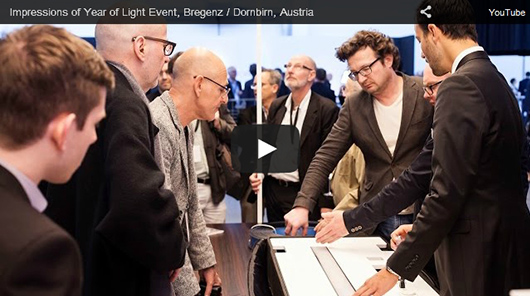
Zumtobel. The Light.-
share it
-
-
03/2015Company
LIGHT IN TIME – Biological light for keeping track of time
Various chronotypes, different daily routines and a variety of locations for work and leisure-time place individual requirements on biologically effective lighting solutions. The following technical paper tells you how light can make a contribution to bringing some kind of order into these varied time-based parameters.More informationLess informationAn integral approach to the effect of lighting – visually, emotionally, biologically!
The most popular office workstations are close to windows, despite potential glare through sunlight. It is near windows that the highest illuminance levels are available for visual tasks (visual lighting effect). An unimpeded view out of the building can enhance people's mood. Moreover, dynamic daylight ensures variation (emotional lighting effect). Our circadian rhythm, our timing system, is stabilised to optimum effect by natural lighting conditions and high light exposure levels close to windows (biological lighting effect).Lighting design for workstations is traditionally based on levels specified in applicable standards, which usually refer to visual and in part also to emotional aspects. The DIN SPEC 67600 standard (04/2013) includes valuable new design recommendations for biologically effective lighting. Here, the factor of time plays a highly decisive role for the first time. Daylight is the most important timer for people's circadian rhythm and has always determined our phases of activity and regeneration – above all before artificial lighting became available in large quantities. The eye is not only the visual sense's central organ. Moreover, the eye with its circadian photoreceptors situated on the retina also acts as an interface for keeping track of time. Information is forwarded to the brain, more precisely to the suprachiasmatic nucleus (SCN) which is considered the central pacemaker of the timing system. Via subsequent physiological processes such as hormonal control, this system fulfils the primary timing function. In addition to daylight, artificial lighting can influence stimulation and a good night's sleep – hence also people's well-being and health.
LIGHT IN TIME – An analysis of nature and people over the course of time
In the integral approach for biologically effective lighting solutions, the focus is on the individual. Artificial lighting has been adjusted according to daylight conditions, allows users to choose individual settings and takes the emotional lighting effect into account.
The time-dependent factors influencing artificial lighting are based on natural geographic and meteorological conditions: changes in incident daylight over the course of a year and underlying weather-based fluctuations. When designing LIGHT IN TIME lighting solutions, the focus is primarily on the individual. Various chronotypes, different schedules and a variety of locations for work and leisure-time place individual requirements on biologically effective lighting solutions. Light can make a contribution to bringing some kind of order into these varied time-based parameters.

The pioneers: new technologies and scientific findings
For the first time, the DIN SPEC 67600:2013-04 standard prepared by experts of various technical disciplines includes specific design recommendations for biologically effective lighting. Thus, innovative technological options and current research findings have been combined. The circadian photoreceptors on the retina are addressed to optimum effect via high intensity levels of the bluish spectral component. However, they must be stimulated within an appropriate time frame. Then reduced reddish light is once again used for the transition to regenerative phases. This necessary change in spectral distributions combined with appropriate illuminance levels is supported by LED technology featuring » tunableWhite to optimum effect. Yet, the biological effects of light should not be reduced to the subject of light colour. The impacts of a variety of design approaches to the circadian system are too complex (see table from the DIN SPEC 67600 standard).Extract from DIN SPEC 67600:2013-04
More intense biological effects of light are produced by Less intense biological effects of light are produced by Higher level of radiation Lower level of radiation Longer duration of exposure Shorter duration of exposure Higher level of blue components Lower level of blue components Wide-area lighting Pinpoint lighting Dynamic changes in lighting Constant lighting Lower level of radiation before the light exposure under review* Morning light is most effective for synchronising the body clock Light in the afternoon affects the body clock to a relatively low extent * Persons who have been adjusted to darkness for an extended period before being exposed to light will be more sensitive to light and show a stronger response LIGHT IN TIME primarily follows nature and the individual
Source: Zumtobel Research, Fraunhofer IAO: Global User Study on Lighting Quality Perceived in Offices.
What to keep in mind when implementing LIGHT IN TIME lighting solutions:
1) Artificial lighting should follow the natural course of daylight as closely as possible and be used only in addition to daylight.
2) Lighting solutions where users are able to adjust lighting conditions individually enjoy a high level of acceptance by users. One of the main consequences of the impact LIGHT IN TIME solutions have on physiological functions is that individual control options must be provided. Hence, people's needs are taken into account and manipulative actions are avoided.
3) The integral approach on lighting effects is essential: it is mainly the emotional and biological effects that are included in the design approach in a well-balanced manner.
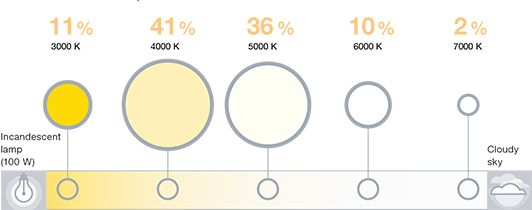
Example: On the one hand, the right amount of light in an intense bluish light colour at the right time has a biologically supporting effect. On the other hand, many people perceive a high blue component as unattractive or even annoying, depending on individual preferences, weather conditions or visual and/or space-defining tasks (see illustration).
Last but not least: optimised LIGHT IN TIME concepts for stabilising the timing system do not start and end at the reception desk of the office building. They continue in people's private living spaces and during leisure-time activities. For instance, doing sports in daylight has a stabilising effect and promotes a sound sleep, whereas extensive exposure to electronic screens in the evening is counterproductive. LIGHT IN TIME is based on a specifically designed sequence of light and darkness over a period of 24 hours – there is a time for everything!
Zumtobel. The Light.
-
share it
-
-
03/2015Products
Red Dot Best of the Best design award for SEQUENCE
In the context of the 2015 Red Dot product awards, the innovative SEQUENCE pendant and surface-mounted LED luminaire has won the “Red Dot: Best of the Best” award for superior design quality and trend-setting design.More informationLess informationSEQUENCE has been developed in collaboration with in-house and external architects, lighting designers and other designers: a completely new luminaire that focuses on visual tasks in offices and fully exploits the opportunities of cutting-edge LED technology.
The luminaire features perfect glare control and is supplied in lengths of 1200 mm (8 lighting modules) or 2100 mm (14 lighting modules). With up to 100 lm/W at a luminous flux of up to 9000 lm, SEQUENCE facilitates economically efficient working in offices.
» Go to product page
Discover the options offered by the innovative luminaire by watching three videos that describe SEQUENCE's integrated intelligence, functional design and customised lighting sequences in detail.
» Go to the videosZumtobel. The Light.
-
share it
-
-
03/2015Products
Red Dot product award for AXON and INTRO
Zumtobel's AXON and INTRO LED luminaires managed to impress the 2015 Red Dot product award jury.More informationLess informationThe uniquely slim AXON pendant LED luminaire combines an attractive linear design with an efficiency of up to 115 lm/W. The indirect/direct luminaire incorporates the latest LED lens technology and thus achieves excellent glare control despite its compact cross-section of only 38 x 38 mm. AXON efficiently illuminates the task area and at the same time uniformly brightens up the ceiling.
» Read more about AXON
The INTRO lighting system offers retailers an efficient lighting solution that can be fully customised to cater for various areas of a store in one and the same design: from shop windows, shelves and recesses through to promotional spaces.
» Read more about INTROZumtobel. The Light.
-
share it
-
-
03/2015Lighting Solution
Texel fruit cooperative benefits from lighting refurbishment
All apples harvested by the 350 members of the Texel fruit cooperative are collected at the cooperative's location in Naturns, South Tyrol, where the apples are sorted and packed up to be marketed all over the world.More informationLess informationThe sorting and storage facilities were refurbished in terms of lighting technology. Not only did the existing lighting system consume too much energy, but it was also unable to provide the required illuminance levels.
Providing 500 lx for the task areas and 300 lx for the conveyor belts is no problem for the new » CRAFT LED high-bay luminaire. Read more about the benefits of the new lighting solution in our project report PDF.
» Go to project reportZumtobel. The Light.
-
share it
-
-
03/2015Products
The expert for logistics applications: TECTON LED Narrow Beam
TECTON LED integrates light source, batten luminaire and reflector into a visual and functional unit. The result is a 100% consistent continuous-row LED system without any interruption.More informationLess informationDeveloped especially for use in logistics applications, the narrow-beam optics ensures uniform, efficient lighting of vertical shelf fronts and appropriate illumination of the corridors between the shelves. With a maximum mounting height of approx. 18 metres, rooms with medium and high ceilings are illuminated perfectly.Zumtobel. The Light.
-
share it
-
-
03/2015Lighting Solution
Gebrüder Weiss save more than 60% of energy thanks to innovative LED lighting solution
Gebrüder Weiss, one of Europe's most important transport and logistics services providers, continues its long-standing collaboration with Zumtobel. At the company's Pöchlarn site, the conventional fluorescent tubes installed in a loading and unloading hall with a floor space of approximately 2.250 square metres have been replaced by the modular TECTON LED continuous-row system solution.More informationLess informationMarkus Nigsch, Head of Property and Facility Management at Gebrüder Weiss, comments on the environmental and economic benefits of the lighting refurbishment: “We have been able to reduce annual power consumption from 1.2 million to less than 465,000 kilowatt hours. This means a reduction of the CO2 emissions related to lighting by almost 139 tonnes a year.”
» Go to project reportZumtobel. The Light.
-
share it
-
-
03/2015Company
New brochure illuminating the subject of logistics
Frequently, logistics buildings comprise enormous cubic content and, accordingly, the energy required by the lighting system is very high. Therefore, energy efficiency is one of the key topics, especially with a view to daily operating costs.More informationLess informationIn our new “Light for Industry and Engineering: Logistics” brochure, you will find everything you need to know about the added value provided by a new lighting solution based on the benefits of innovative luminaires and intelligent lighting control. LED lighting solutions open up a new dimension in terms of durability, reliability and efficiency. Higher illuminance levels and improved glare control enhance the employees' productivity and help avoid errors.
» Go to brochureZumtobel. The Light.
-
share it
-
-
02/2015Lighting Solution
Two Zumtobel LED products distinguished by iF DESIGN AWARDS
Once again, Zumtobel has obtained first-class awards for its design competence: Prizes were awarded by the jury of the iF DESIGN AWARD 2015 to the SEQUENCE and INTRO LED luminaires on account of their outstanding product design and efficient lighting technology.More informationLess informationThe 53-member jury of experts of the iF DESIGN AWARD 2015 acknowledged the creative power of the SEQUENCE LED pendant and surface-mounted luminaire and of the INTRO LED spotlight system in the product design category.
For Zumtobel, intelligent design has to meet both aesthetic and functional requirements. Independently and in close collaboration with internationally renowned designers, the Zumtobel product design team develops products that are outstanding on account of their maximum performance and unobtrusive design. Once again, Zumtobel's ambition in this area has been acknowledged by these most recent awards.
Read more about the winners on our product pages:
» Go to SEQUENCE LED pendant and surface-mounted luminaire
» Go to INTRO LED spotlight system
The awards will be presented at the BMW World in Munich on 27 February 2015.
Zumtobel. The Light.-
share it
-
-
02/2015Company
Heron relies on NOW! – light that pays for itself
During the next eight years, the Zumtobel Group will be responsible for operating the industrial lighting of Heron, an Austrian manufacturer of automation components.More informationLess informationThe Zumtobel Group will be responsible for operation of Heron's industrial lighting over the next eight years. The turnkey package comprises replacement of the existing lighting system, installation and commissioning of the new energy-efficient Zumtobel lighting solution as well as energy monitoring and maintenance of the system. The refurbishment is being implemented in close collaboration with the company's electrical engineering partner, Elektro Willi from Andelsbuch.
Zumtobel's Executive Vice President Thomas Bischof explains the range of services provided: "Installation of energy-efficient LED luminaires will reduce energy and maintenance costs by 52% each month. Billing will be done via the reduction of operating costs achieved." Christian Beer, managing partner of the Heron Group, says: "As we do not have to spend any money on investments, the funds remain available for product development, from which our customers will benefit in the long run."
Without any additional costs, Heron will get a new lighting system providing higher illuminance levels. "The Zumtobel experts provided competent advice and compiled a package specifically tailored to our needs. The Heron Group is provided with a one-stop solution, including energy monitoring and any maintenance tasks that may come up, and no longer needs to bother about its lighting system. We get long-term security in terms of lighting and energy savings,“ Christian Beer summarises the customer benefits.
In Stage 1, the lighting system in one hall will be refurbished and the illumination level increased from 300 to the required 400 lx. Old inefficient high-bay luminaires will be replaced. Heron opted for a high-quality Zumtobel lighting solution involving 76 196 W CRAFT LED luminaires with a service life of 50,000 hours. Despite a higher illuminance level, energy and cost savings of 52% are guaranteed. In Stage 2, the façade and garden lighting will be replaced.
» Read more about NOW! – light that pays for itself.
Zumtobel. The Light.-
share it
-
-
02/2015Lighting Solution
PANOS infinity: maximum luminaire efficiency and outstanding colour rendering
With a luminaire efficiency of up to 120 lm/W, PANOS infinity has again set new standards on the market. This outstanding luminaire efficiency is achieved through the use of innovative LED multichannel technologies featuring red/white boards and other high-grade components that are combined within the optical luminaire system.More informationLess informationWith Ra levels exceeding 90, PANOS infinity stableWhite ranks first among LED downlights in terms of quality. PANOS infinity is available all over the world in the colour temperatures of 2700 K, 3000 K and 4000 K.Zumtobel. The Light.
-
share it
-
-
01/2015Company
Use Zumtobel Limbic® Lighting to address your target groups
Especially in the area of retail and presentation, the effectiveness of light is closely related to the buying motives of the customers addressed. Based on the scientific Limbic® Lighting study, Zumtobel has been able to devise three basic concepts. Various target groups can thus be addressed using fundamentally different lighting design principles.More informationLess informationRead our special page and find out how to make use of the study results to optimise the lighting system in order to increase the customers' sense of well-being, extend the amount of time they spend in a store and hence the probability of them making a purchase decision.
» Go to special pageZumtobel. The Light.
-
share it
-
-
01/2015Company
New “Light for presentation and retail” brochure
Lighting scenarios that are geared towards specific target groups are becoming increasingly important in presentation and retail. Authenticity, customisation, the miniaturisation of luminaires and high-precision accent lighting are all crucial factors in the design of such lighting solutions.More informationLess informationIn three chapters entitled Retail, Automotive and Supermarket, the new “Light for presentation and retail” application brochure addresses the relevant aspects of lighting design. We tell you how you can use intelligent lighting design to boost your sales and at the same time save energy and thus costs.
» Download brochureZumtobel. The Light.
-
share it
-
-
01/2015Lighting Solution
New Spar flagship store with LED-only lighting solution
For the new market hall of the Spar retail chain in Budapest, Zumtobel has implemented an efficient LED lighting concept for presenting the goods displayed to optimum effect while creating a pleasant ambience that makes customers feel at ease and turns shopping into an experience.More informationLess informationThe market hall with its sophisticated architectural design situated at the “MOM Park” was designed by the Budapest-based architects' studio LAB5. In close coordination with the architects, Zumtobel has implemented an efficient LED lighting solution that completely blends into the interior and ensures optimum presentation of the products using accent lighting. Read our project report to learn which lighting solutions were installed and how the freshness of the food displayed is highlighted in a targeted manner.
» Go to project reportZumtobel. The Light.
-
share it
-
-
01/2015Lighting Solution
Pictures of the Amsterdam Light Festival
Themed “A Bright City”, the Amsterdam Light Festival turned the Dutch Capital into a huge festival of lighting art from 27 November 2014 to 18 January 2015.More informationLess informationThe “Water Colors” boat route allowed visitors to experience spectacular works of art, some of which even interacted with passers-by.
More than 40 lighting artworks designed by international artists had been installed along the Illuminade, a walking route for pedestrians, transforming the city into a luminous metropolis. Zumtobel was the main sponsor of the event. For pictures of the festival, please refer to » www.lightlive.com.
» Go to pictures (© Janus van den Eijnden)Zumtobel. The Light.
-
share it
-
-
01/2015Event
Kick-off event for the “International Year of Light” in Amsterdam
Even before UNESCO's official kick-off event in Paris to open the “International Year of Light and Light-based Technologies (IYL2015)”, another event regarding this topic was held in Amsterdam on 15 January.More informationLess informationOn the initiative of UN Ambassador Rogier van der Heide and Kobus Kuipers, Head of the Nanophotonics Department at the FOM Institut AMOLF, world-renowned personalities such as Robbert Dijkgraaf and Ben van Berkel held presentations on lighting topics involving a number of disciplines. The fascinating afternoon event was hosted by Rogier van der Heide, Chief Marketing & Design Officer Zumtobel Group. All videos showing the presentations held in English are available at » lightlive.com.Zumtobel. The Light.
-
share it
-
-
01/2015Lighting Solution
Zumtobel Masterpieces Collection
15. January 2015 – 28. February 2015More informationLess informationTo conclude the » Amsterdam Light Festival, Zumtobel brings a selection of Masterpieces in the field of light art to Amsterdam.
Starbrick – Olafur Eliasson
eL – Daniel Libeskind
VorteXX – Zaha Hadid & Patrik Schumacher
LQ Chandelier – Hani Rashid
The best give the best of themselves
Artists, building artists and designers use light for space planning. Zumtobel helps them to realise their visionary ideas. In close collaboration with protagonists of our time, this creates absolute masterpieces. Armature on the one hand, piece of art on the other hand, these Masterpieces are a driving force for innovations at Zumtobel. For this collection the best give the best of themselves, think of: Olafur Eliasson, Zaha Hadid, Daniel Libeskind, Hani Rashid – and Zumtobel.
Further information: » www.zumtobel.com/masterpieces
ARCAM
Prins Hendrikkade 600
1011 VX Amsterdam
» www.arcam.nl
Opening hours Tuesday – Sunday 1:00 – 5:00 pmZumtobel. The Light.
-
share it
-
-
01/2015Lighting Solution
Maison Ullens designer label illuminated by Zumtobel LED lighting
OMA, the international architects' studio based in Rotterdam, was commissioned with developing the design concept for the first “Maison Ullens” boutique in Paris.More informationLess informationIn the new flagship store, the latest fashion is illuminated to optimum effect by the minimalist yet powerful VIVO XS LED spotlight. Thanks to excellent colour rendering of Ra > 90, the high-quality fabrics are set centre-stage authentically and gently.
Read our project report to learn which Zumtobel products are used for providing pleasantly uniform ambient lighting and targeted accent lighting on the shelves.
» Read moreZumtobel. The Light.
-
share it
-
-
01/2015Products
Three products won Good Design Awards
As many as three products by Zumtobel managed to impress the jury of the renowned Good Design Award.More informationLess informationFrom more than 700 entries from 36 countries, a jury based in New York and Los Angeles selected the most outstanding product designs to receive a Good Design Award. As many as three products by Zumtobel – the VIVO XS LED spotlight, the modular INTRO LED lighting system and the LIGHT FIELDS evolution LED luminaire range – won the coveted Good Design Award 2014 for their design and their lighting quality.
VIVO XS LED spotlight
With its compact diameter of just 65 mm, VIVO XS is the smallest commercially available spotlight for powerful retail lighting (up to 1,000 lm) and is therefore ideally suitable for illuminating relatively small retail premises. The smallest model in the VIVO product range owes its tiny dimensions to an innovative combination of passive cooling and a compact LED optic. Despite its reduced dimensions, it is big when it comes to lighting quality: the spotlight stands out thanks to its high colour rendering index (Ra > 90) and highly effective light distribution which provides high luminance levels.
Design: EOOS
» Read more about VIVO XS
INTRO LED lighting system
The INTRO lighting system offers retailers an efficient lighting solution that can be fully customised to cater for various areas of a store: from shop windows, shelves and recesses through to activity spaces – INTRO can be used in any area. The system is based on spotlight modules that can be aligned flexibly and even be combined in various light colours or beam angles, depending on the lighting task. Lighting modules separated from the mounting frame provide designers and architects with plenty of creative scope.
By developing liteCarve® reflector technology, Zumtobel has mastered a challenge that has presented a problem so far: balanced rectangular light distribution by means of a freeform reflector. Based on a point light source, the reflector directs 100 % of the light indirectly and in a targeted manner, thus allowing for illumination of vertical surfaces, shelves and displays.
Design: Chris Redfern, Sottsass Associati
» Read more about INTRO
LIGHT FIELDS evolution LED luminaire range
A design revolution has been made possible by integrating light-emitting diodes into the frame of the LIGHT FIELDS evolution luminaire. The low-profile lighting module accomplishes demanding lighting projects in a consistent design language with effortless ease. From recessed and surface-mounted through to free-standing or pendant luminaires: each luminaire incorporates a specifically developed brilliant MPO+ micro-pyramidal optic that meets all exacting visual requirements at the workplace.This optic is precisely tuned to suit the distribution characteristics of the LED lighting points, and guarantees glare-free light (UGR < 19 and L65 < 1500 cd/m²) as well as highly diffuse light distribution. This makes reflected glare on notebooks and tablets a thing of the past. Thanks to tunableWhite technology, users can adjust the colour temperature of the LIGHT FIELDS evolution LED luminaire range continuously between 3000 K and 6000 K.
Design: Chris Redfern, Sottsass Associati
» Read more about LIGHT FIELDS evolution
About the Good Design Award
The Good Design Award, one of the world's most renowned industrial design programmes, was established in Chicago in 1950. The Good Design Award programme was founded by the architects Eero Saarinen, Ray and Charles Eames and former MOMA director Edgar Kaufmann Jr. and is organised by the Chicago Athenaeum Museum for Architecture and Design, in collaboration with the European Centre for Architecture, Art Design and Urban Studies. “Good Design” is an international trademark for innovative design. The awards are given to high-quality products that cannot fail to impress in terms of form, function and aesthetics.
Zumtobel. The Light.-
share it
-
Filter
Service for specialist media
Contact
Schweizer Strasse 30
A-6850 Dornbirn
Phone: +43 (5572) 390-0
Email: [email protected]
» http://www.zumtobel.com

-532.jpg)
-98.jpg)
-98.jpg)
-98.jpg)
-98.jpg)
-98.jpg)
